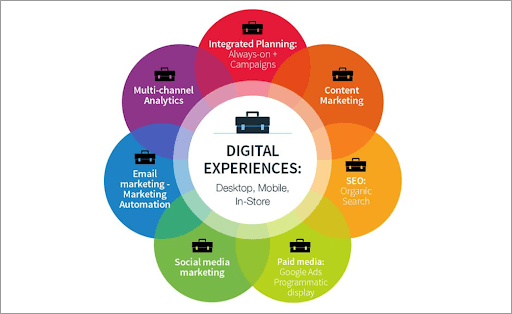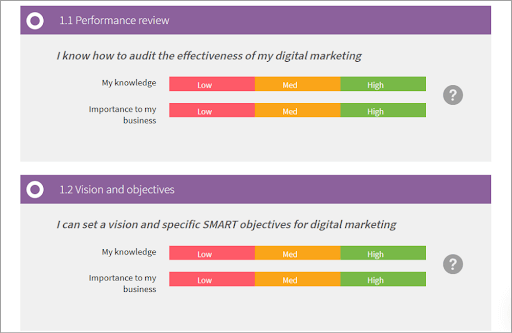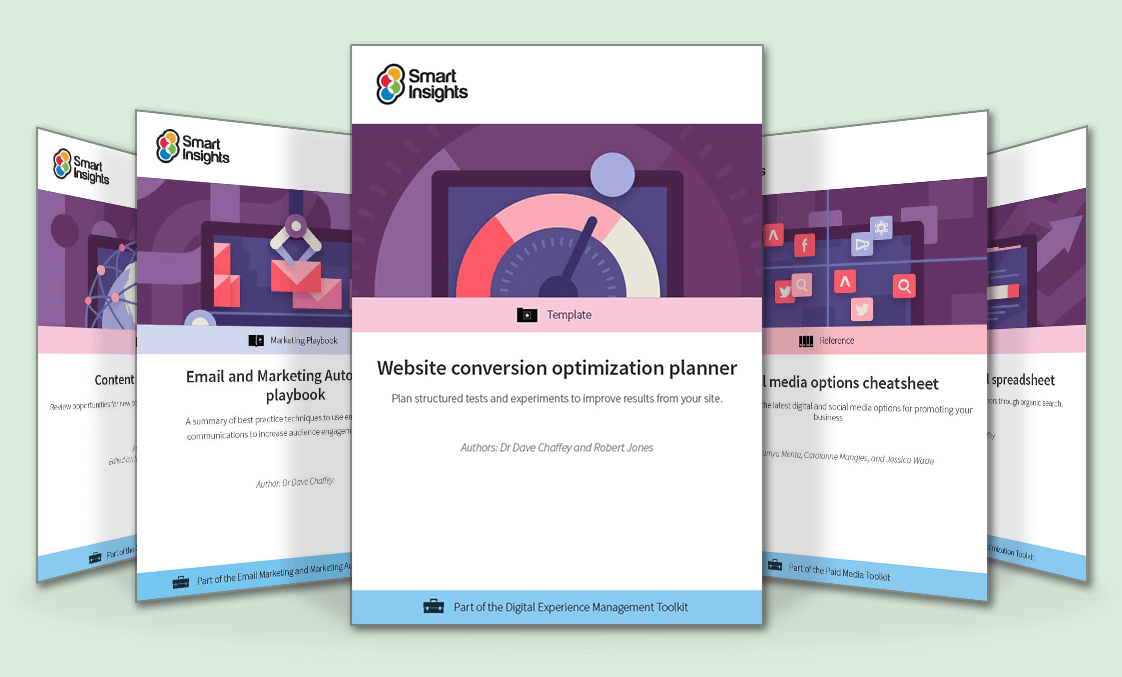Now more than ever it’s essential to amplify the impact of your digital marketing management. Here we show you how to do this by boosting both your operational and leadership effectiveness.
It’s essential to boost your management skills
Now, more than ever, how you prioritize and execute your projects matters for effective digital marketing management. Without operational discipline, you’ll soon find yourself staring at the backs of your competitors.
In another Smart Insights article, I talked about how to boost the productivity of your team ( https://www.smartinsights.com/digital-marketing-strategy/5-keys-to-work-from-home-success-during-coronavirus-times/ ) during these Coronavirus times. Here I focus on how to improve your productivity and, more importantly, your effectiveness as a leader.
Boosting your impact involves:
-
Prioritizing your marketing initiatives
-
Optimizing your marketing workflows
-
Outsourcing applicable work
-
Empowering your functional leads
I will drill into each topic below.

Create an initiative-impact table
To increase your team’s impact, you first need to document all of the initiatives they’re working on, and why you’re doing them. Only then can you prioritize them and optimize their execution.
Download our Individual Member Resource – Content marketing strategy guide
This guide shows you both how to develop a strategy to deploy content across all your online marketing and gives practical tips to make it happen.
Access the Content marketing strategy guide
Start by listing all your functional leads (SEO, PPC, Email, CRO, etc.). Then do the following:
-
Send them a shared spreadsheet containing these columns:
-
Project
-
Initiative (project category)
-
Weekly burn rate (budget spend)
-
Customer (internal, external)
-
Deliverables
-
Tell your leads to add all of their monthly and quarterly projects to this sheet.
-
After you get everyone’s sheets, copy their data into your master sheet.
-
Append the following new columns to your master ‘prioritization’ sheet:
-
Priority - High, medium, low (to be added later)
-
How well each project aligns with a SMART marketing objective. Color-code as:
-
Green (highly aligned with objectives)
-
Yellow (somewhat aligned with objectives)
-
Red (misaligned with objectives)
-
Estimated financial value (revenue growth, cost reduction)
-
Estimated intangible value (brand image, customer loyalty, etc.)
-
Outsourceable work? (if you clearly define the process and steps)
Not familiar with SMART objectives? SmartInsights founder Dave Chaffey lays out how to write SMART objectives here ( https://www.smartinsights.com/digital-marketing-strategy/how-to-set-digital-marketing-objectives/ ).
Financial Value is defined as ‘the incremental financial value gained as a result of the marketing investment.’ You should be able to get this by speaking with someone from your finance department and /or your lead data analyst.
Intangible Value is the non-monetary value of the work — how it builds things like your brand image or customer loyalty. (While brand image and customer loyalty often result in lower customer acquisition and retention costs, you don’t need to include those here.)
Now prioritize your initiatives by a combination of these five columns. Since you and other marketing managers should factor strategy into consideration, I prefer this to be a subjective judgment (vs. a purely quantitative decision).
Now you can confidently focus on these initiatives. And ‘put on your blinders’ to cease the non-value-added work.
How to upskill yourself in this area
If you need to upskill in corporate finance, Coursera offers this highly-rated ‘Finance for Non-finance Professionals’ course.
If you’re looking to go deeper, the University of California, San Diego offers an affordable online Finance Certification program through their Extension division.
In either case, since you’ll be studying online, you’ll need to exercise some professional development time management discipline. If you haven’t learned this yet, you’ll soon need to, as more classroom courses transition to the online format.
Optimize your marketing project workflows
Now it’s time to optimize your marketing initiatives and projects. Start by killing the ‘red’ initiatives. They’re burning precious team bandwidth while producing little value. What’s more, by pulling team members away from higher-value projects, they have a high opportunity cost.
Next, start to optimize your ‘yellow’ initiatives. For these, think of two types of optimizations: ‘First-order’ and ‘second-order.’ First-order updates boost your team’s impact by the greatest amount. Second-order updates deliver a more moderate return on your team’s time investment.
Here’s an analogy: when I optimize the conversion rates of websites, after first doing some customer research ( https://www.smartinsights.com/digital-marketing-strategy/customer-insights/ ) I do bold tactical redesigns that lift my baseline conversion metrics (conversion rate, revenue per visitor, etc.). Then, using this updated design as my ‘conversion baseline,’ I plan and run split tests that further optimize specific aspects of the user experience. In this example, the tactical redesigns are the first-order updates, and the split tests are the second-order updates. Strategic updates, like adding new marketing technology, often produce first-order impacts.
Document your workflows
You could hire a top-tier business process reengineering (BPR) or customer experience (CX) consultancy to help with this, but these agencies charge steep hourly rates. So, unless you have a robust budget, you’ll need to do this yourself (or outsource it; more on that later).
The upside of the DIY approach: you’ll become intimately familiar with each step, and how it fits within the larger workflow. So you’ll be better able to optimize your workflows over time.
As you optimize your flows ask yourself:
What workflows and tasks can be automated - either partially or fully?
How can I optimize this workflow? (Hint: ask your project team members)
How can I build ‘issue triggers’ into my project ground rules?
How can I get my leads to promptly act on these triggers
In this Smart Insights article ( https://www.smartinsights.com/digital-marketing-strategy/to-insource-or-outsource-a-critical-question-for-digital-marketers/ ) I dive into how to optimize your marketing project workflows. Building issue triggers is mainly a leadership act — encouraging open communication and not ‘shooting the messenger’ when bad news surfaces.
How to upskill yourself in this area
If your project management (PM) app already includes a ‘workflow documentation’ feature, assign your leads to learn and use these features. PM apps Monday, Insightly and Asana have these built-in, as does Smartsheet. If you just need a stand-alone app, LucidChart is a good option.
Don’t just stop with documenting workflows. Dig into where they’re working well and where they aren’t. Discuss with your project leads which gaps are most critical to fix now versus later.

Boldly outsource all applicable work
Always bear in mind: your team doesn’t have to do it all! You only have so many hours in a day. So, when applicable, handoff projects (or parts of projects) to a freelance person or team.
Just be sure to:
-
Set clear expectations around:
-
Expected outcomes
-
Timing constraints (deadlines)
-
Specify (‘spec’):
-
The task you’re assigning
-
Your internal owner
-
Do frequent status checks (with project owners)
I’m the first to admit that it can be tough to trust you’ll get good, timely results when working with outsourced (perhaps even offshore) resources. But if you follow the above steps, it’s more likely to happen. If a given resource doesn’t meet your expectations or ‘specs,’ exercise some patience and try another one.
While you may experience some frustration in the near term, your team will end up saving a lot of time and money in the long term. Better yet, once you lock in trusted resources, and repeatedly use them, you’ll support gig economy workers who are suffering the economic effects of the Coronavirus crisis.
Reference the same article I mentioned above ( https://www.smartinsights.com/digital-marketing-strategy/to-insource-or-outsource-a-critical-question-for-digital-marketers/ )for further guidance on outsourcing.
A word of caution
When deciding what to outsource, I recommend that you avoid outsourcing tasks that ‘carry a high communication premium.’ Examples of these task types are strategic work like website redesigns or advert campaign creative. These tasks tend to require lots of in-person meetings and work product iteration.
How to upskill yourself in this area
Watch this two-minute video from digital marketing guru Neil Patel ( https://youtu.be/_CF6r_Ol3HA ) to get two quick outsourcing platform recommendations.
Spend some time sifting through these sites looking for freelancers with strong skill sets and stellar reputations. Then pass these names along to your functional leads for consideration. Then continue with the try — assess — iterate — lock-in process I shared above.

Empower your functional leads
The last way to amplify your marketing team’s impact is by exercising your ‘leader leverage.’
Armed with your SMART objectives, a task-level breakdown of their initiatives, and outsourced production resources, empower your various marketing leads to execute their tactical projects with confidence.
Remember to include ‘issue notification triggers’ in your working ground rules so you’ll be brought in to discuss issues sooner than later. And check in with your leads and project managers regularly to synch-up work across your marketing team.
Make it clear that you’re not the ‘project firefighter’ — that, at least for non-critical issues, you expect your leads to analyze issues and propose solutions before they coming running to you.
A few other leadership best practices:
-
Schedule regular ‘coaching and feedback’ sessions with your leads
-
Write ‘thank you’ notes to people who are doing things well (or better than before)
-
Share feedback with the ‘sandwich’ method (praise, provide feedback, encourage).
Your goal should be to get your team thinking and working more autonomously, thereby lessening their daily dependence on you over time. And by doing you’ll develop the leadership skills of everyone on your team.
How to upskill yourself in this area
Smart Insights contributor Gavin Llewellyn offers great guidance on this topic ( https://www.smartinsights.com/managing-digital-marketing/personal-career-development/how-to-transition-from-a-manager-to-a-leader/ ). Read and heed this to take your marketing leadership to the next level.

Unsure where to start? Take our Learning Plan Assessment
If you’re not sure how to create your professional learning plan, take our Personalized Learning Assessment ( https://www.smartinsights.com/members/individuals-dashboard/ ). It takes less than five minutes and gives you a Digital Skills Score.
The assessment outputs a specific action plan for shoring up your marketing and leadership skill deficiencies. As you do more training, with Smart Insights or elsewhere, you can track your skill growth over time.
Start making more impact now
With the world’s economy — and maybe also your business — during a slowdown, it’s more essential than ever for your team to impact your company’s success. By adding these four tactics to your management skillset, you’ll help ensure the growth of your profit margins and brand value in the coming months. And more of your team members will become leaders during the process.













